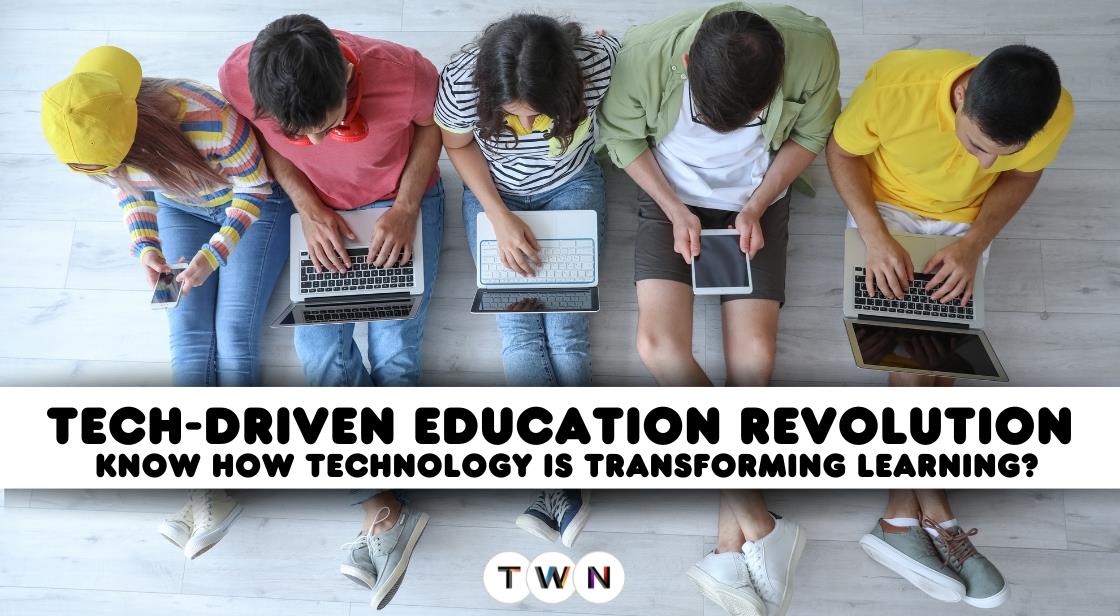Tech-Driven Education Revolution: How Technology is Transforming Learning ?

Blog Post
In the 21st century, technology has become a pervasive force that shapes almost every facet of our lives. Education, an essential cornerstone of human development, is no exception to this sweeping transformation.
The integration of technology into education has catalyzed a revolution that transcends traditional boundaries, fundamentally altering the way we teach, learn, and access knowledge.
From the advent of smart classrooms to the proliferation of e-learning platforms, from harnessing the power of artificial intelligence to the immersive realms of virtual reality, this article embarks on a journey through the dynamic landscape of tech-driven education and its profound implications for the future.
Technology is not just changing education; it's shaping a more accessible, personalized, and hands-on learning environment for students. As we delve into the following sections, we will explore various ways technology is fueling an educational revolution, from improving accessibility and offering personalized instruction to fostering hands-on learning experiences.
The blog post not only highlights the benefits of these technological advancements but also delves into some of the challenges that need to be addressed for a more comprehensive understanding of the tech-driven education landscape. It also touches upon the future of education, where artificial intelligence promises to take personalization and accessibility to new heights.
Let's embark on this enlightening journey through the realm of technology-driven education, a world where the boundaries of traditional classrooms are rapidly blurring, and where knowledge is no longer confined by geographical limitations.
In the 21st century, technology has been a transformative force across various aspects of our lives, and education is no exception. The integration of technology in education has ushered in a revolution, reshaping the way we learn, teach, and access knowledge.
From smart classrooms to e-learning platforms, artificial intelligence to virtual reality, this article explores the dynamic landscape of tech-driven education and its far-reaching implications.
Technology is transforming learning in many ways, from making education more accessible to providing students with personalized instruction and opportunities for hands-on learning.
Technology is having a profound impact on education, transforming the way students learn and teachers teach. From online learning platforms to interactive whiteboards, technology is making education more accessible, engaging, and effective.
Here are some of the ways technology is driving an education revolution:
How Technology is Transforming Education?
Making education more accessible:
In the modern age, technology is at the forefront of an education revolution, breaking down barriers and creating opportunities for students of all backgrounds, regardless of where they live or their economic circumstances. The advent of online learning platforms has transformed the way education is delivered, offering a flexible and accessible approach to learning. Furthermore, educational apps and interactive games have emerged as valuable supplements to traditional classroom teaching methods.
Enhancing Accessibility:
Technology has disrupted the conventional model of education by making it accessible to a broader audience. Regardless of geographical location, students can now embark on their learning journeys from virtually anywhere. This accessibility is particularly significant in remote or underserved regions, where traditional educational resources may be scarce.
Online Learning Platforms:
Online learning platforms are leading the charge in democratizing education. Institutions and educators worldwide are harnessing the power of the internet to offer courses, lectures, and resources to a global audience. Learners can choose from a diverse array of subjects and fields of study, and they have the flexibility to progress at their own pace. This adaptability is particularly advantageous for working professionals, parents, and those with busy schedules, as it allows them to integrate education seamlessly into their lives.
Customized Learning:
One of the remarkable aspects of technology in education is its capacity to personalize the learning experience. Adaptive learning algorithms assess each student's strengths and weaknesses, enabling tailored content delivery. This personalization ensures that students receive the support they need in challenging areas while accelerating through familiar material. It fosters a more profound understanding of the subject matter.
Educational Apps and Games:
Educational apps and games have transcended the realm of entertainment and emerged as potent educational tools. These applications engage students in interactive quizzes, challenges, and rewards, making the learning process more enjoyable and immersive. They are particularly effective with younger learners who respond positively to gamified learning experiences. By incorporating game elements, education becomes both fun and effective.
Also Read : How Online Learning Platforms Are Revolutionizing Healthcare Education
1. Providing personalized instruction:
Personalized instruction is a teaching approach that tailors the learning experience to the individual needs and abilities of each student. Technology can be used to deliver personalized instruction in a variety of ways, including:
-
Adaptive learning software: Adaptive learning software uses artificial intelligence (AI) to track a student's progress and adjust the difficulty of the material accordingly. This can be helpful for students who are struggling with a particular concept or who are ahead of the class and need more challenging material.
-
Online tutoring platforms: Online tutoring platforms allow students to connect with qualified tutors for one-on-one support. Tutors can help students with a variety of tasks, such as explaining difficult concepts, providing homework help, and preparing for tests.
-
Learning management systems (LMSs): LMSs are used by teachers to deliver online courses and manage student learning. LMSs typically include features such as online discussion forums, assignments, and quizzes. Teachers can use LMSs to differentiate instruction for students by providing different levels of support or by offering different types of assignments.
Here are some specific examples of how technology is being used to provide personalized instruction in the classroom:
-
In a math class, students are using adaptive learning software to practice solving equations. The software tracks each student's progress and adjusts the difficulty of the problems accordingly. Students who are struggling with a particular concept can receive extra help from the software, while students who are ahead of the class can be challenged with more difficult problems.
-
In a science class, students are using an online tutoring platform to get help with a homework assignment on photosynthesis. The tutor explains the concept to the student and helps them to complete the assignment.
-
In an English class, students are using an LMS to complete a research paper on a topic of their choice. The teacher uses the LMS to provide feedback on each student's work and to offer suggestions for improvement.
Benefits of personalized instruction:
Personalized instruction can offer a number of benefits for students, including:
-
Increased student engagement and motivation: When students are receiving instruction that is tailored to their individual needs and interests, they are more likely to be engaged and motivated to learn.
-
Improved student achievement: Research has shown that personalized instruction can lead to improved student achievement in a variety of subjects.
-
Reduced achievement gaps: Personalized instruction can help to reduce achievement gaps between students from different backgrounds.
-
Increased student satisfaction: Students who receive personalized instruction are more likely to be satisfied with their education.
Challenges of personalized instruction:
While personalized instruction offers a number of benefits, there are also some challenges associated with it. One challenge is that it can be time-consuming for teachers to differentiate instruction for each student. Another challenge is that it can be difficult to assess student learning when students are working on different tasks.
2. Creating opportunities for hands-on learning:
Hands-on learning is a teaching approach that allows students to learn by doing. It is essential for student engagement and understanding, as it allows students to experience concepts firsthand and to apply what they are learning to real-world problems.
Technology can be used to create opportunities for hands-on learning in a variety of ways, including:
Virtual reality (VR) and augmented reality (AR) simulations:** VR and AR simulations allow students to experience complex concepts in a safe and controlled environment. For example, students can use VR simulations to explore the solar system or to learn about the human body. AR simulations can be used to allow students to see how historical events unfolded or to learn about how different machines work.
3D printing and other makerspace tools: 3D printing and other makerspace tools allow students to design and create their own projects. This can help students to develop their critical thinking and problem-solving skills, as well as their creativity and innovation.
Here are some specific examples of how technology is being used to create opportunities for hands-on learning in the classroom:
-
In a science class, students are using VR simulations to learn about the different planets in the solar system. They can explore the surfaces of the planets and learn about their atmospheres and climates.
-
In a history class, students are using AR simulations to learn about the Battle of Gettysburg. They can see how the battle unfolded and learn about the different strategies that were used by the Union and Confederate armies.
-
In a math class, students are using 3D printing to design and create their own geometric shapes. They can then use the shapes to learn about different mathematical concepts, such as volume and surface area.
-
In a science class, students are using makerspace tools to design and build their own robots. They can then use the robots to compete in challenges or to solve problems.
Benefits of hands-on learning:
Hands-on learning offers a number of benefits for students, including:
-
Increased student engagement and motivation: Students are more likely to be engaged and motivated to learn when they are actively involved in the learning process.
-
Improved student achievement: Research has shown that hands-on learning can lead to improved student achievement in a variety of subjects.
-
Increased student satisfaction: Students who engage in hands-on learning are more likely to be satisfied with their education.
Challenges of hands-on learning:
While hands-on learning offers a number of benefits, there are also some challenges associated with it. One challenge is that it can be time-consuming for teachers to plan and implement hands-on activities. Another challenge is that it can be difficult to assess student learning when students are working on hands-on projects.
3. Online learning platforms:
Online learning platforms are web-based platforms that offer students access to a variety of educational resources, including courses, tutorials, and assessments. These platforms can be used to supplement traditional classroom instruction or to complete entire degrees online.
Some of the most popular online learning platforms include Coursera, EdX, and Udemy. These platforms offer a wide range of courses on a variety of topics, including business, computer science, engineering, humanities, and languages.
Here are some of the benefits of using online learning platforms:
-
Convenience: Online learning platforms offer students the convenience of learning from anywhere at any time. Students can learn at their own pace and on their own schedule.
-
Affordability: Online courses are often more affordable than traditional classroom courses.
-
Variety: Online learning platforms offer a wide variety of courses on a variety of topics. Students can find courses that meet their individual needs and interests.
-
Quality: Online courses are often taught by experienced and qualified instructors.
Here are some examples of how online learning platforms are being used in education:
-
Students in traditional classrooms are using online learning platforms to supplement their classroom instruction. For example, a student in a math class might use an online learning platform to practice solving equations or to watch video tutorials on complex concepts.
-
Students are using online learning platforms to complete entire degrees online. There are now many accredited universities that offer online degrees. This is a good option for students who want to earn a degree but who cannot attend a traditional university.
-
Companies are using online learning platforms to train their employees. For example, a company might use an online learning platform to train its employees on a new software program or on a new company policy.
4. Interactive whiteboards:
Interactive whiteboards (IWBs) are large digital displays that allow teachers and students to interact with them using a stylus or their fingers. IWBs are typically mounted on the wall at the front of the classroom, and they can be used to display a variety of content, including presentations, videos, web pages, and documents.
IWBs offer a number of benefits for teachers and students, including:
-
Increased student engagement: IWBs can help to increase student engagement by providing a more interactive and visually appealing learning experience.
-
Improved student achievement: Research has shown that students who learn using IWBs tend to achieve higher scores on standardized tests.
-
Reduced teacher workload: IWBs can help to reduce teacher workload by providing teachers with a variety of ready-made resources and by making it easier to create and deliver engaging lessons.
Here are some specific examples of how IWBs are being used in the classroom:
-
A math teacher uses an IWB to display a lesson on geometry. The teacher can drag and drop geometric shapes on the IWB to demonstrate different concepts. The teacher can also ask students to come to the IWB to solve problems or to create their own geometric shapes.
-
A science teacher uses an IWB to display a video on the life cycle of a butterfly. The teacher can pause the video and ask students questions about what they are seeing. The teacher can also use the IWB to draw diagrams or to label parts of the butterfly.
-
A history teacher uses an IWB to display a map of the United States. The teacher can click on different states on the map to learn more about their history and geography. The teacher can also ask students to come to the IWB to label different states or to identify historical landmarks.
Also Read : Top Books in the World To Read Before You Die: A Journey Through Literary Masterpieces
5. Educational apps and games:
Educational apps and games are digital tools that can be used to teach a wide range of subjects, from math and science to history and language arts. These apps and games can be used in the classroom or at home to supplement traditional instruction.
Educational apps and games offer a number of benefits for students, including:
-
Increased student engagement: Educational apps and games can help to increase student engagement by providing a more interactive and visually appealing learning experience.
-
Improved student achievement: Research has shown that students who learn using educational apps and games tend to achieve higher scores on standardized tests.
-
Development of critical thinking and problem-solving skills: Many educational apps and games require students to think critically and solve problems in order to progress. This can help students to develop important skills that will be useful in school and in life.
-
Differentiated instruction: Educational apps and games can be used to provide differentiated instruction for students of all levels. For example, students who are struggling with a particular concept can use educational apps and games to get extra practice. Students who are ahead of the class can use educational apps and games to challenge themselves and learn more about topics that they are interested in.
Here are some specific examples of educational apps and games that are being used in the classroom:
-
Khan Academy Kids: Khan Academy Kids is a free app that teaches children ages 2-8 early learning skills such as reading, writing, and math. The app uses games, songs, and stories to engage children and help them learn.
-
Duolingo: Duolingo is a free app that teaches people new languages. The app uses games and interactive exercises to help users learn new vocabulary and grammar.
-
Minecraft Education Edition: Minecraft Education Edition is a version of the popular video game Minecraft that is designed for use in the classroom. Minecraft Education Edition includes features such as lesson plans, challenges, and collaborative tools that can be used by teachers to teach a variety of subjects.
6. Adaptive learning software:
Adaptive learning software is a type of educational software that uses artificial intelligence (AI) to personalize the learning experience for each student. The software tracks the student's progress and adjusts the difficulty of the lessons accordingly. This ensures that students are challenged but not overwhelmed.
Adaptive learning software offers a number of benefits for students, including:
-
Improved student achievement: Research has shown that students who learn using adaptive learning software tend to achieve higher scores on standardized tests.
-
Increased student engagement: Adaptive learning software can help to increase student engagement by providing a more challenging and rewarding learning experience.
-
Reduced teacher workload: Adaptive learning software can help to reduce teacher workload by providing teachers with insights into student progress and by making it easier to differentiate instruction.
Here are some specific examples of how adaptive learning software is being used in the classroom:
-
A math teacher uses adaptive learning software to help students learn algebra. The software tracks each student's progress and provides them with personalized practice problems. The software also provides the teacher with reports on student progress so that the teacher can identify students who need extra help and differentiate instruction accordingly.
-
A science teacher uses adaptive learning software to help students learn about the human body. The software allows students to explore the human body in 3D and to learn about different organs and systems. The software also provides students with quizzes and other assessments to help them track their progress.
-
A language arts teacher uses adaptive learning software to help students learn to read. The software provides students with personalized reading passages and activities based on their reading level. The software also provides the teacher with reports on student progress so that the teacher can identify students who need extra help and differentiate instruction accordingly.
Here are some names of adaptive learning software:
-
IXL
-
Khan Academy Kids
-
Duolingo
-
Minecraft Education Edition
-
Lumosity
-
Memrise
-
Quizizz
-
Kahoot!
-
Socrative
-
Edpuzzle
These are just a few examples, and there are many other adaptive learning software programs available.
Please note that some of the software listed above may not be specifically designed for adaptive learning, but they can be used in an adaptive way by teachers. For example, Minecraft Education Edition can be used to create personalized learning experiences for students by using different game modes, challenges, and tools.
7. Online tutoring platforms:
Online tutoring platforms are web-based platforms that allow students to connect with qualified tutors for one-on-one support. These platforms can be used by students of all ages and levels, and they can cover a wide range of subjects, including math, science, English, history, and foreign languages.
Online tutoring platforms offer a number of benefits for students, including:
-
Convenience: Online tutoring can be accessed from anywhere at any time, which is convenient for students who have busy schedules or who live in remote areas.
-
Flexibility: Online tutoring sessions can be scheduled at the student's convenience, and students can choose to work with different tutors until they find one who is a good fit for them.
-
Affordability: Online tutoring is often more affordable than traditional in-person tutoring.
-
Personalized instruction: Online tutors can provide students with personalized instruction based on their individual needs and learning styles.
Here are some specific examples of how online tutoring platforms are being used by students:
-
A student who is struggling in math can use an online tutoring platform to connect with a math tutor for one-on-one help. The tutor can help the student to understand difficult concepts, complete homework assignments, and prepare for tests.
-
A student who is preparing for the SAT or ACT can use an online tutoring platform to connect with a test prep tutor. The tutor can help the student to develop a study plan, review test material, and practice taking test questions.
-
A student who is learning a new language can use an online tutoring platform to connect with a language tutor. The tutor can help the student to learn new vocabulary and grammar, practice speaking and writing the language, and prepare for language exams.
Overall, online tutoring platforms can be a valuable tool for students of all ages and levels. When used effectively, online tutoring can help students to improve their grades, develop their skills, and reach their full potential.
Here are some examples of popular online tutoring platforms:
-
Tutor.com
-
Chegg Tutors
-
Varsity Tutors
-
Club Z
-
Preply
-
Cambly
-
italki
-
Verbling
-
TutorMe
-
GoStudent
-
Tutors.com
8. Open Educational Resources (OER):
Open Educational Resources (OER) are teaching, learning, and research materials that are either in the public domain or licensed with creative commons, no-cost, open access licenses, which allow anyone to use, adapt, and share them freely. OER can include textbooks, course materials, modules, streaming videos, tests, assessment tools, software, and other resources.
Benefits of OER
OER offer a number of benefits for students, educators, and institutions, including:
-
Affordability: OER are free to use and adapt, which can help to reduce the financial burden on students and institutions.
-
Access: OER are accessible to anyone with an internet connection, which can help to increase access to education for students in developing countries and other underserved populations.
-
Quality: OER can be of high quality, and are often created and peer-reviewed by experts in the field.
-
Flexibility: OER can be adapted and customized to meet the specific needs of students and instructors.
-
Collaboration: OER can foster collaboration and resource sharing among educators.
Examples of OER
Here are some examples of OER:
-
Textbooks: OpenStax College textbooks are free to use and adapt, and are available in a variety of formats, including digital, print, and interactive.
-
Course materials: The MERLOT repository contains a wide range of free and open course materials, including syllabi, lectures, assignments, and assessments.
-
Modules: The Connexions project provides a free and open online platform for creating and sharing educational modules.
-
Streaming videos: Khan Academy offers a variety of free and open streaming videos on a variety of subjects.
-
Tests and assessment tools: The Open Assessment Library contains a variety of free and open test and assessment items.
-
Software: The Open Source Initiative maintains a directory of free and open source software.
How to use OER
OER can be used in a variety of ways in the classroom. For example, instructors can use OER to:
-
Supplement or replace traditional textbooks and other course materials.
-
Create custom course materials that are tailored to the specific needs of their students.
-
Collaborate with other educators to create and share resources.
-
Provide students with access to high-quality educational materials at no cost.
The future of education:
Technology is rapidly transforming the education landscape, and artificial intelligence (AI) is at the forefront of this transformation. AI is already being used to develop personalized learning programs, provide students with feedback on their work, and automate administrative tasks. In the future, we can expect to see even more innovative and effective ways to use AI to teach and learn.
Here are some specific examples of how AI is being used in education today:
-
Personalized learning: AI-powered learning platforms can track student progress and adjust the difficulty of lessons accordingly. This ensures that students are always challenged but never overwhelmed.
-
Feedback: AI can provide students with real-time feedback on their work, helping them to identify and correct their mistakes.
-
Automation: AI can automate administrative tasks, such as grading essays and scheduling appointments, freeing up teachers to focus on teaching.
Here are some examples of how AI could be used in education in the future:
-
Virtual tutors: AI-powered virtual tutors could provide students with one-on-one tutoring on any subject. This would be especially helpful for students in underserved communities or who have difficulty accessing traditional tutoring services.
-
Adaptive textbooks: AI-powered adaptive textbooks could customize the learning experience for each student. The textbook could automatically adjust the difficulty of the material and provide students with personalized practice problems.
-
Real-time translation: AI-powered real-time translation could help students who are learning a new language. The translation software could translate the teacher's lecture or the textbook into the student's native language.
Conclusion:
Overall, AI has the potential to revolutionize education by making it more personalized, effective, and accessible for all students. As AI technology continues to develop, we can expect to see even more innovative and transformative ways to use AI to teach and learn.
The tech-driven education revolution is well underway. Technology is making education more accessible, engaging, and effective for all students. As technology continues to evolve, we can expect to see even more innovative and transformative ways to use technology to teach and learn.
You May Like
EDITOR’S CHOICE












